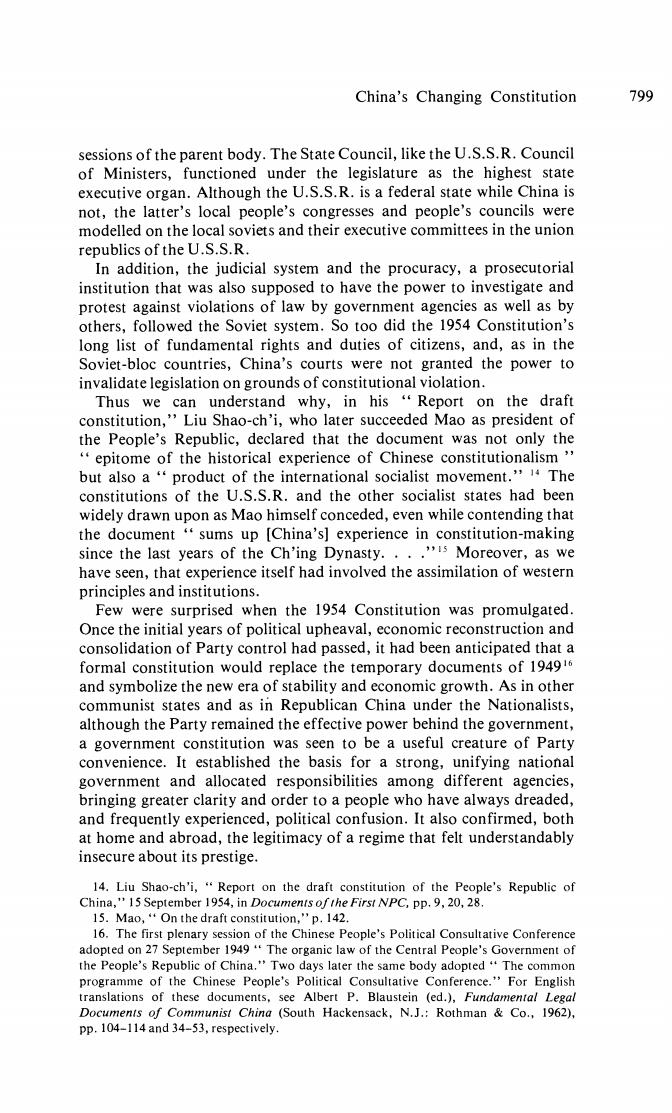正在加载图片...

China's Changing Constitution 799 sessions of the parent body.The State Council,like the U.S.S.R.Council of Ministers,functioned under the legislature as the highest state executive organ.Although the U.S.S.R.is a federal state while China is not,the latter's local people's congresses and people's councils were modelled on the local soviets and their executive committees in the union republics of the U.S.S.R. In addition,the judicial system and the procuracy,a prosecutorial institution that was also supposed to have the power to investigate and protest against violations of law by government agencies as well as by others,followed the Soviet system.So too did the 1954 Constitution's long list of fundamental rights and duties of citizens,and,as in the Soviet-bloc countries,China's courts were not granted the power to invalidate legislation on grounds of constitutional violation. Thus we can understand why,in his "Report on the draft constitution,"'Liu Shao-ch'i,who later succeeded Mao as president of the People's Republic,declared that the document was not only the epitome of the historical experience of Chinese constitutionalism" but also a"product of the international socialist movement."4 The constitutions of the U.S.S.R.and the other socialist states had been widely drawn upon as Mao himself conceded,even while contending that the document "sums up [China's]experience in constitution-making since the last years of the Ch'ing Dynasty...."s Moreover,as we have seen,that experience itself had involved the assimilation of western principles and institutions. Few were surprised when the 1954 Constitution was promulgated. Once the initial years of political upheaval,economic reconstruction and consolidation of Party control had passed,it had been anticipated that a formal constitution would replace the temporary documents of 194916 and symbolize the new era of stability and economic growth.As in other communist states and as in Republican China under the Nationalists, although the Party remained the effective power behind the government, a government constitution was seen to be a useful creature of Party convenience.It established the basis for a strong,unifying national government and allocated responsibilities among different agencies, bringing greater clarity and order to a people who have always dreaded, and frequently experienced,political confusion.It also confirmed,both at home and abroad,the legitimacy of a regime that felt understandably insecure about its prestige. 14.Liu Shao-ch'i,Report on the draft constitution of the People's Republic of China,"15 September 1954,in Documents of the First NPC,pp.9,20,28. 15.Mao,"On the draft constitution,"p.142. 16.The first plenary session of the Chinese People's Political Consultative Conference adopted on 27 September 1949"The organic law of the Central People's Government of the People's Republic of China."Two days later the same body adopted"The common programme of the Chinese People's Political Consultative Conference."For English translations of these documents,see Albert P.Blaustein (ed.),Fundamental Legal Documents of Communist China (South Hackensack,N.J.:Rothman Co.,1962), pp.104-114 and 34-53,respectively.China's Changing Constitution 799 sessions of the parent body. The State Council, like the U.S.S.R. Council of Ministers, functioned under the legislature as the highest state executive organ. Although the U.S.S.R. is a federal state while China is not, the latter's local people's congresses and people's councils were modelled on the local soviets and their executive committees in the union republics of the U.S.S.R. In addition, the judicial system and the procuracy, a prosecutorial institution that was also supposed to have the power to investigate and protest against violations of law by government agencies as well as by others, followed the Soviet system. So too did the 1954 Constitution's long list of fundamental rights and duties of citizens, and, as in the Soviet-bloc countries, China's courts were not granted the power to invalidate legislation on grounds of constitutional violation. Thus we can understand why, in his " Report on the draft constitution," Liu Shao-ch'i, who later succeeded Mao as president of the People's Republic, declared that the document was not only the " epitome of the historical experience of Chinese constitutionalism " but also a " product of the international socialist movement." 14 The constitutions of the U.S.S.R. and the other socialist states had been widely drawn upon as Mao himself conceded, even while contending that the document " sums up [China's] experience in constitution-making since the last years of the Ch'ing Dynasty...."15 Moreover, as we have seen, that experience itself had involved the assimilation of western principles and institutions. Few were surprised when the 1954 Constitution was promulgated. Once the initial years of political upheaval, economic reconstruction and consolidation of Party control had passed, it had been anticipated that a formal constitution would replace the temporary documents of 194916 and symbolize the new era of stability and economic growth. As in other communist states and as in Republican China under the Nationalists, although the Party remained the effective power behind the government, a government constitution was seen to be a useful creature of Party convenience. It established the basis for a strong, unifying national government and allocated responsibilities among different agencies, bringing greater clarity and order to a people who have always dreaded, and frequently experienced, political confusion. It also confirmed, both at home and abroad, the legitimacy of a regime that felt understandably insecure about its prestige. 14. Liu Shao-ch'i, " Report on the draft constitution of the People's Republic of Ch ina, " 15 September 1954, in Documents of the First NPC, pp . 9 , 20, 28 . 15. Mao, " On the draft constitution, " p . 142. 16. The first plenary session of the Chinese People's Political Consultative Conference adopted on 27 September 1949 " The organic law of the Central People's Government of the People's Republic of China." Two days later the same body adopted " The common programme of the Chinese People's Political Consultative Conference." For English translations of these documents, see Albert P. Blaustein (ed.), Fundamental Legal Documents of Communist China (South Hackensack, N. J .: Rothman & Co., 1962), pp.104-114and34-53,respectively